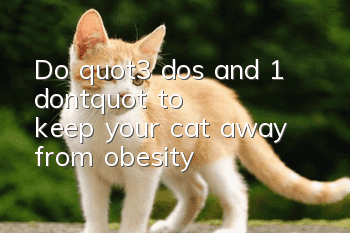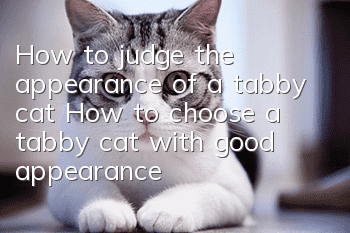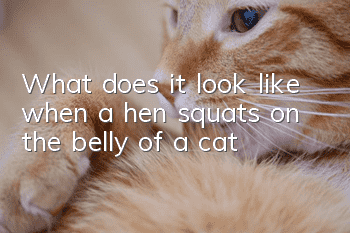Do "3 dos and 1 don't" to keep your cat away from obesity

If your cat is too obese, do the "3 dos and 1 don'ts" to keep your cat away from the pain caused by obesity. Although the chubby and chubby cat owner is loved by everyone, cats are two-legged animals like us. Similarly, their obesity will also affect the cat's health and even lead to heart disease, diabetes and other problems. Therefore, in order for pets to be healthy and live happily with you, the cat owner, cat owners must understand some of the harm caused by obesity to cats, and learn how to help cats lose weight. Stop using the excuse that cats are fat, weird, and cute to tempt cats to eat more and not lose weight!
So how should we judge whether a cat is overweight and needs to lose weight? First, let’s look at overweight: a cat whose weight exceeds its breed standard weight by 15%-30% is called overweight. The second is obesity: a cat whose weight exceeds the standard weight of its species by more than 30% is considered obese. Finally, judge whether the cat is obese by looking at it: when the cat cannot touch the standard at all, the exposed area of the shoulders is almost three times that of the head, the mobility slows down, and the daily water intake is reduced by 200 ml, then it means that your cat owner is really Need to lose weight.
After we know how to judge whether a cat is obese, before losing weight, we must understand what kind of harm obesity will bring to the cat. Only then will you have the perseverance to persist in doing it, or you can do two things for the cat. You may have to give up on exercising every day. The harms of obesity to cats include: symptoms of metabolic disorders, endocrine disorders, folliculitis (similar to human acne), and hair loss; in addition, it can easily lead to infertility and miscarriage after pregnancy; and skeletal deformities can occur. , arthritis, hind limb paralysis and other symptoms; it also causes insulin secretion imbalance, causing diabetes. Complications caused by diabetes such as liver disease, kidney disease, and pancreatitis may even occur; it can also increase the burden on the heart, leading to a series of diseases such as heart disease.
After knowing the symptoms of overweight cats, how can we help cats lose weight? Below I will teach you the "3 yes and 1 no" four-step weight loss method to help cats lose weight scientifically:
First of all, the first step: the first of the 3 points is to formulate a scientific regular and quantitative feeding plan. Regular and quantitative feeding can help cats calculate the calories they consume and help them lose weight. You can draw up a weight loss plan for cats. A normal cat’s daily calorie intake = weight (kg) * 30 + 70. According to this formula, arrange the cat’s daily feeding amount. You can also simply reduce the cat's current daily food intake by 1/4 and help the cat lose weight scientifically at a rate of 0.5%-2% per week. It is not advisable to lose weight too slowly or too quickly to avoid affecting health. During the weight loss period, cats should be urged to drink more water every day, feed them regularly, and do not adopt a self-service approach. It can be fed two or three times a day. Swap red meat for lower-fat white meat or fish. Instead of feeding snacks, cook some carrots yourself, broccoli, pumpkin and boiled chicken breast to give your cat a taste. Don’t indulge your cat occasionally just because of his pitiful little eyes. The entire weight loss process requires patience.
The second important thing is to let the cat exercise more to speed up metabolism. Overweight cats are generally too lazy to move, so their metabolism will be too slow, resulting in the remaining calories and fat in the body being unable to be consumed and accumulated. So if you want to help your cat lose weight, you also need to make it move. You can use cat teasers, laser pointers, etc. to interact and play games with cats for more than half an hour every day. You can also divide the cat's food rations into several cat bowls and place them in various places in the house, forcing the cat to walk more to fill its stomach. You can also hang some small dried fish at a high place so that the cat can get food through exercise.
The third important thing is to improve the cat’s gastrointestinal digestion and digest excess fat. Many cat owners believe that cats do not need nutrition during weight loss. This idea is wrong. For cats who are losing weight, supplementing with vitamins and probiotics is more conducive to improving the body's metabolism and thus improving the weight loss effect. During the weight loss period, cats can be fed six kinds of Guden bacteria every day to help them promote gastrointestinal peristalsis and reduce the accumulation of excess calories. In addition, vitamins help to transform fat. In order to prevent cats from malnutrition during weight loss, you can feed Guden vitamin tablets once a day.
Final point: Don’t implement a vegan diet. Some people say that cats are fat because they eat meat, so they should try a vegetarian diet. This idea is also wrong. Different from human beings who are omnivorous, cats are pure carnivorous animals. Their body's ability to digest and absorb fiber and carbohydrates is less than 20%. If they eat vegetarian food for a long time, their bodies will suffer from malnutrition, which will consume their own muscles to compensate and cause organ failure. Symptoms of exhaustion.
- How to bathe a cat scientifically and safely
- Why does a cat hiccup?
- What should I do if my cat doesn’t know how to use cat litter?
- What are the symptoms of Addison's disease in pet cats? Diagnosis and treatment of symptoms of Addison's disease in cats!
- Why do cats like to stay around when they go to the toilet?
- Beginner’s Guide to Cat Raising: Teach you step-by-step how to choose deworming medicine for cats?
- How to get rid of the smell of cat urine
- Can female cats be neutered in summer?
- Will the male cat come back after leaving home for a few days?
- Can pet cats drink Nongfu Spring?



